I do not have experience with loops but it looks like I will need to create some of them to analyze my data properly. Could you show how to create a simple loop on the code which I already created ? Let's use looping to get some plots:
pdf(file = sprintf("complex I analysis", tbl_comp_abu1), paper='A4r')
ggplot(df_tbl_data1_comp1, aes(Size_Range, Abundance, group=factor(Gene_Name))) +
theme(legend.title=element_blank()) +
geom_line(aes(color=factor(Gene_Name))) +
ggtitle("Data1 - complex I")+
theme(axis.text.x = element_text(angle = 90, hjust = 1))
ggplot(df_tbl_data2_comp1, aes(Size_Range, Abundance, group=factor(Gene_Name))) +
theme(legend.title=element_blank()) +
geom_line(aes(color=factor(Gene_Name))) +
ggtitle("Data2 - complex I")+
theme(axis.text.x = element_text(angle = 90, hjust = 1))
ggplot(df_tbl_data3_comp1, aes(Size_Range, Abundance, group=factor(Gene_Name))) +
theme(legend.title=element_blank()) +
geom_line(aes(color=factor(Gene_Name))) +
ggtitle("Datas3 - complex I")+
theme(axis.text.x = element_text(angle = 90, hjust = 1))
dev.off()
The question now is what I would like to achieve. So first of all I have like 10 complexes to analyze so that means 10 pdf files should be created and the example shows plots from three different data sets for the complex one. To make it properly the number in variable comp1 (from df_tbl_dataX_comp1) has to be changed from 1 to 10 - depends which complex we want to plot. The next thing which has to be changed through the loop is the name of pdf file and each of graphs... Is it possible to write such loop ?
Data:
structure(list(Size_Range = structure(c(1L, 1L, 1L, 2L, 2L, 2L,
3L, 3L, 3L, 4L, 4L, 4L, 5L, 5L, 5L, 6L, 6L, 6L, 7L, 7L, 7L, 8L,
8L, 8L, 9L, 9L, 9L, 10L, 10L, 10L, 11L, 11L, 11L, 12L, 12L, 12L,
13L, 13L, 13L, 14L, 14L, 14L, 15L, 15L, 15L, 16L, 16L, 16L, 17L,
17L, 17L, 18L, 18L, 18L, 19L, 19L, 19L, 20L, 20L, 20L), .Label = c("10",
"34", "59", "84", "110", "134", "165", "199", "234", "257", "362",
"433", "506", "581", "652", "733", "818", "896", "972", "1039"
), class = "factor"), Abundance = c(0, 0, 0, 0, 0, 0, 0, 0, 0,
0, 0, 0, 0, 0, 0, 0, 0, 142733.475, 108263.525, 98261.11, 649286.165,
3320759.803, 3708515.148, 6691260.945, 30946562.92, 180974.3725,
4530005.805, 21499827.89, 0, 15032198.54, 4058060.583, 0, 3842964.97,
2544030.857, 0, 1640476.977, 286249.1775, 0, 217388.5675, 1252965.433,
0, 1314666.05, 167467.8825, 0, 253798.15, 107244.9925, 0, 207341.1925,
15755.485, 0, 71015.85, 14828.5075, 0, 25966.2325, 0, 0, 0, 0,
0, 0), Gene_Name = c("AT1G01080", "AT1G01090", "AT1G01320", "AT1G01420",
"AT1G01470", "AT1G01560", "AT1G01800", "AT1G02150", "AT1G02500",
"AT1G02560", "AT1G02780", "AT1G02880", "AT1G02920", "AT1G02930",
"AT1G03030", "AT1G03090", "AT1G03110", "AT1G03130", "AT1G03220",
"AT1G03230", "AT1G03330", "AT1G03475", "AT1G03630", "AT1G03680",
"AT1G03870", "ATCG00420", "ATCG00470", "ATCG00480", "ATCG00490",
"ATCG00500", "ATCG00650", "ATCG00660", "ATCG00670", "ATCG00740",
"ATCG00750", "ATCG00842", "ATCG01100", "ATCG01030", "ATCG01114",
"ATCG01665", "ATCG00770", "ATCG00780", "ATCG00800", "ATCG00810",
"ATCG00820", "ATCG00722", "ATCG00744", "ATCG00855", "ATCG00853",
"ATCG00888", "ATCG00733", "ATCG00766", "ATCG00812", "ATCG00821",
"ATCG00856", "ATCG00830", "ATCG00900", "ATCG01060", "ATCG01110",
"ATCG01120")), .Names = c("Size_Range", "Abundance", "Gene_Name"
), row.names = c(NA, -60L), class = "data.frame")
